|
|
|
|
|
It's hard to believe that session I and Gesher B are nearly over! We are still moving at full speed, filling our last days together with chugim, tiyulim, yahadut, etgar showcases and much more. Here are some highlights from the past week: 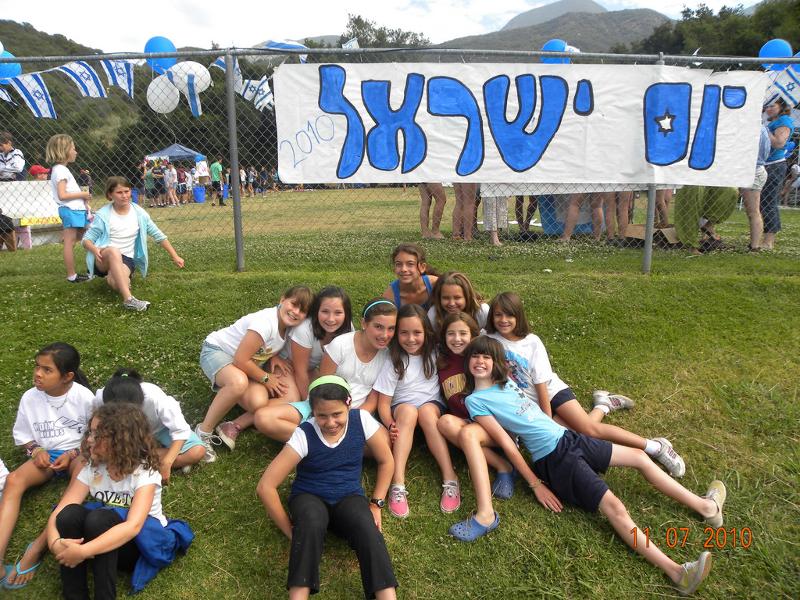 On Sunday morning, the mishlachat ( Israeli staff) hosted Yom Yisrael, a day of learning about and celebrating Israel. The theme of this session's Israel carnival was "Cultures of Israel," with booths highlighting the many cultural influences in Israel. On Sunday evening, the cultural arts staff hosted the Dalia festival, in which each edah performed a song and dance in Hebrew themed around the 100th anniversary of the kibbutz movement. See the July 11 and 12 sections of our website for photos and the news section of the website for more information about these events. 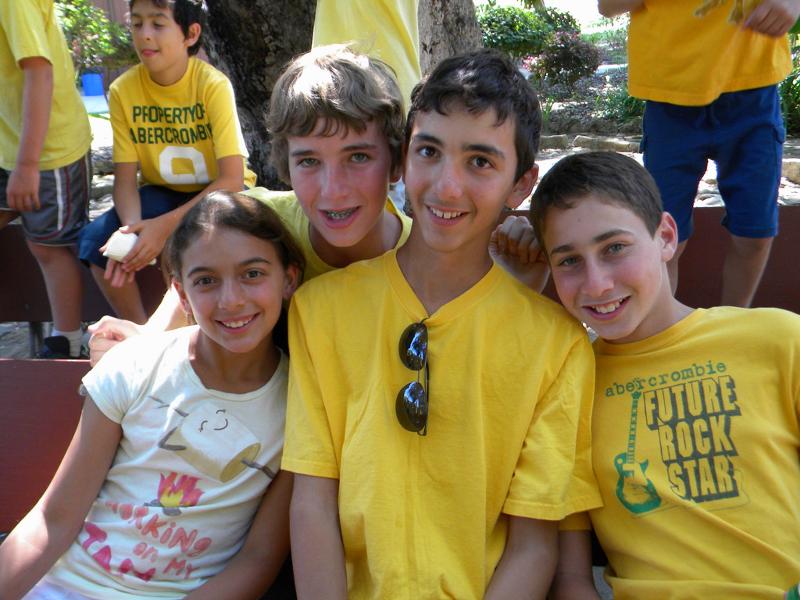 From even before opening ceremonies on Monday night until Tuesday evening's closing ceremonies, Maccabiah fever took hold of camp, with signs (and campers!) painted in the team colors of adom (red), kahol (blue), yarok (green) and tzahov (yellow). Athletic competitions officially began with basketball skills events on Monday before dinner. All campers were encouraged to participate in each of three event categories on Tuesday: swimming, track and field and wacky/fun competitions, which included such classic events as three-legged races, wheelbarrow races and dizzybats. After the competitions ended, everyone came together as a camp for a refreshing barbecue dinner, followed by closing ceremonies in Kikar Zion. In the end, adom finished in first place, but the central theme of the day was sportsmanship and camaraderie. See the July 13 photo album on our website for Maccabiah pictures. Amitzim campers and Ezra staff enjoyed their tiyul Wednesday and Thursday by visiting the Santa Barbara zoo and then camping at El Capitan beach in Santa Barbara. Also on Wednesday, Ramahcappella, our very own a cappella group comprised of campers and staff, began recording this summer's CD, Live from the Givah Volume V, engineered by veteran Ramahnik and current Rosh Musica David Ross. 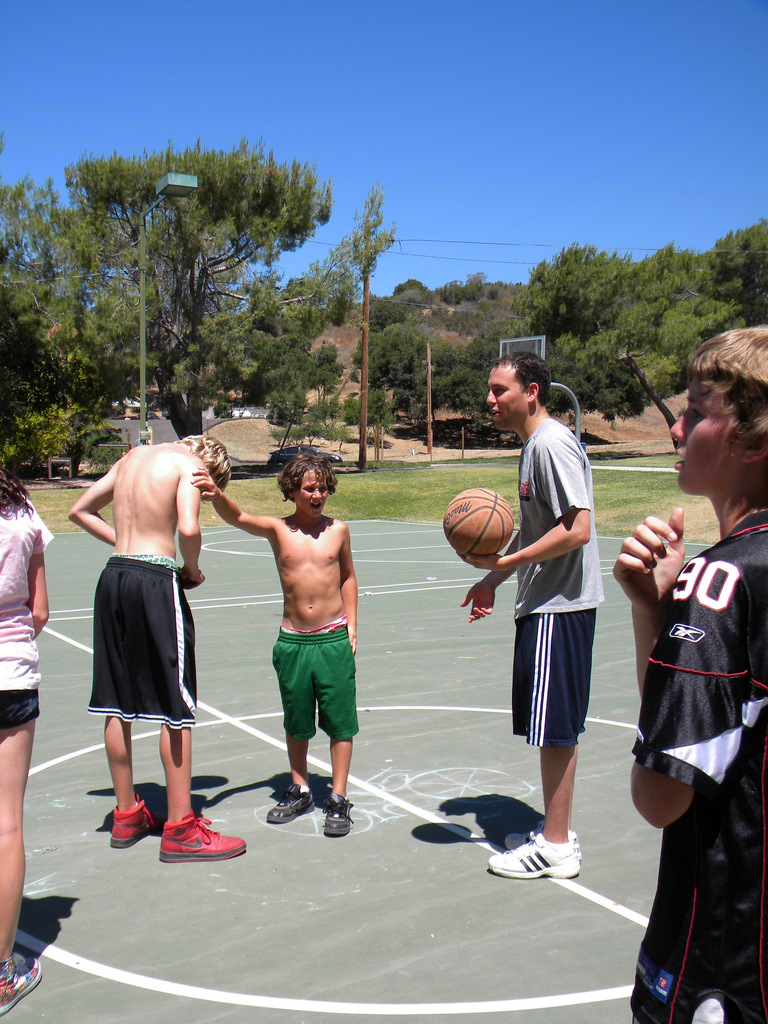 Campers of all ages also had the opportunity this week to improve their basketball skills with Joel Abelson. Abelson has served as an assistant coach for one of the NBA's Developmental League teams and is currently training players to prepare for the NBA draft. Abelson helped campers work on individual skill development through position-specific fundamentals, speed and agility training, shooting techniques, ball handling and dribbling, footwork and balance, passing techniques, and both individual and team defense. Several of our etgar classes had the opportunity to take field trips this week to build on what they have learned throughout the session. Etgar ohmanut (art) toured several local art & ceramics galleries in nearby downtown Ojai. The ultimate Frisbee group traveled to Lake Casitas to play on their expansive Frisbee golf course. Etgar fitness hiked into town and toured Rainbow Bridge, a local health food store. 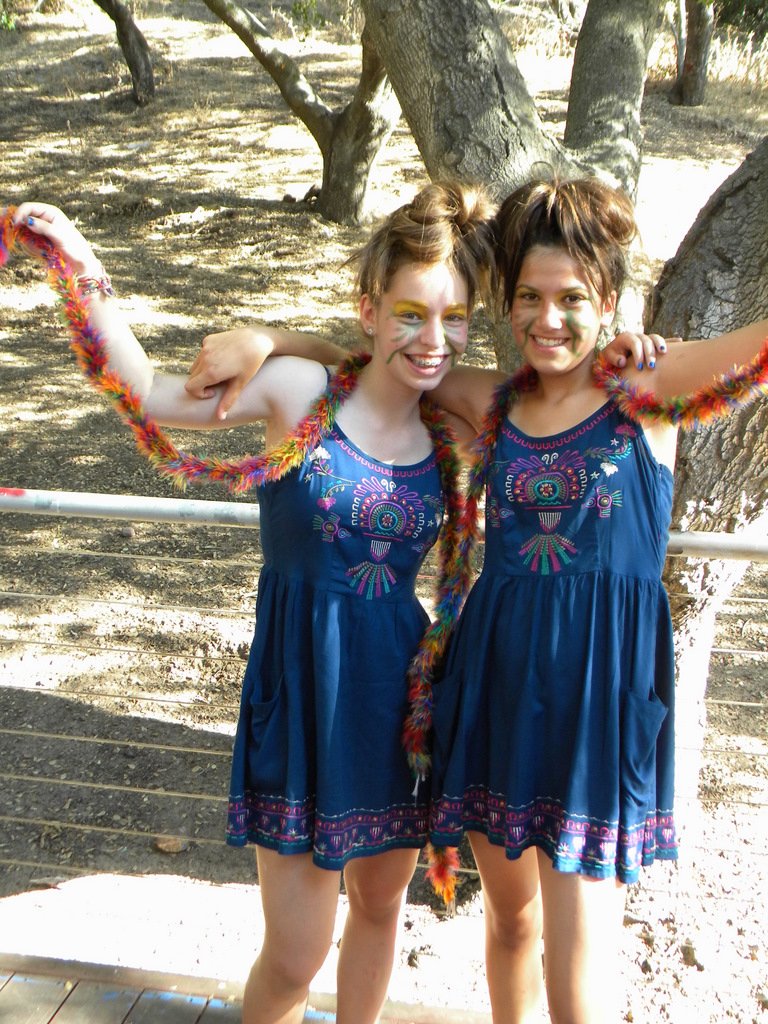 Our drama chugim worked throughout the session learning lines, creating sets and rehearsing for their plays, which are performed entirely in Hebrew. On Wednesday, Giborei Yisrael performed The Lion King, and Sollelim performed The Wizard of Oz. Performances continued on Thursday night during Leil Hofa'ah, with Tzofim presenting Fiddler on The Roof, an original dance routine by the hip hop chug, and performances by the Sollelim and etgar camper bands. On Friday afternoon, the Etgar showcase provided an opportunity for all campers to view artwork and photography created throughout the session by our etgar classes. Giborei Yisrael also hosted a photography exhibit based on their "Jewish Lens" yahadut curriculum. Photos of these events will be posted after Shabbat.
Each Friday during lunch, we recognize one camper from every Edah who was "caught" performing a mitzvah or exemplifying one of the midot (positive qualities) that we model at Camp Ramah. The list of campers who received these M & M Awards will be available in the news section of our website after Shabbat. Ongoing throughout the week were two programs by visiting artist-in-residence Noah Greenberg from Safed, Israel. In the Kesher Tefillin workshop, 21 Sollelim campers made their own set of tefillin from start to finish, learning the complex halachot of tefillin along the way. Greenberg also presented the amazing Tree of Life Shtender, which he co-created with artist David Moss over an 18-year period, to all edot. Please see the full article about Kesher Tefillin below. Photos from Kesher Tefillin can be found in the July 11 section of our website. 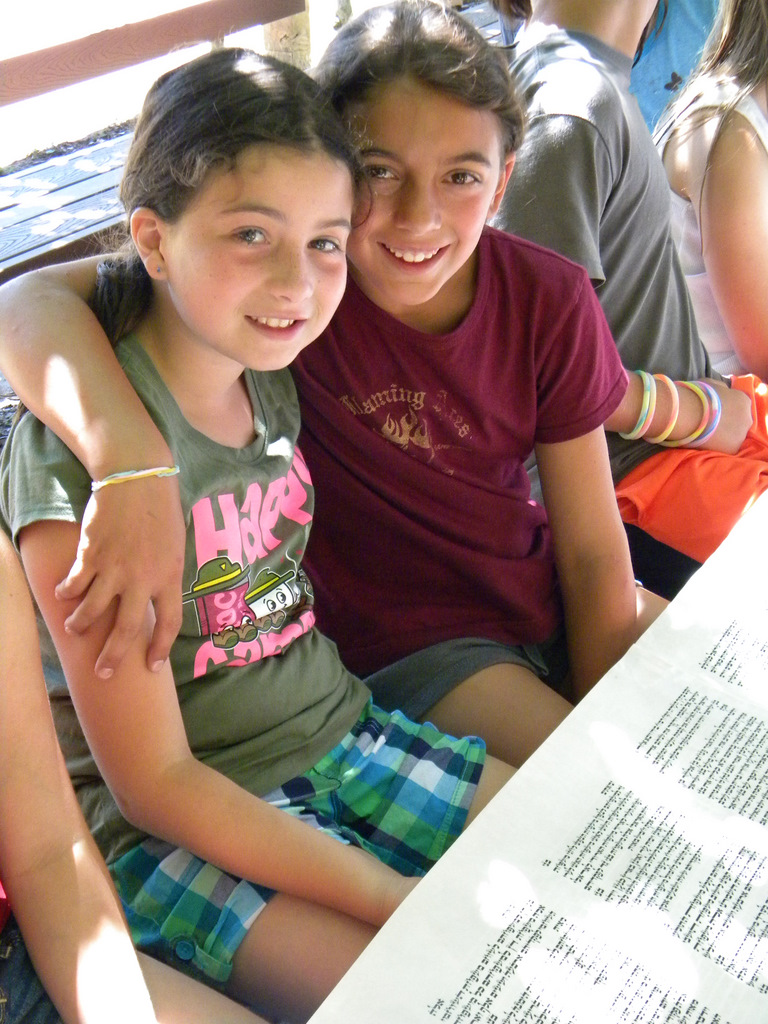 Our last Shabbat will be bittersweet as the end of an amazing session approaches. But we will soak in the sweetness of one more wonderful Shabbat as a time to pray, learn, sing, play and just be together at beautiful Machaneh Ramah.
Shabbat Shalom! |

Rabbi Daniel Greyber and Dr. Zach Lasker
Executive Director and Camp Director
Camp Ramah in California
|
|
Meaning and History: Torah from Rabbi Dan
Ask most people "What is the earliest tragedy in Jewish history commemorated by Tisha B'Av?" and they will tell you the destruction of the First Temple. But Jewish tradition maintains that the sorrows associated with the 9th of Av go back much farther: to the sin of the spies in the desert. While such an attribution is less history than myth - in the deepest sense of the word - it is nonetheless significant that Mishnah Ta'anit (4:6) reads:
Five catastrophes befell our ancestors on the 17th of Tammuz and five on Tisha B'Av...On the 9th of Av, (1) it was decreed against our ancestors that they would not enter the land [of Israel] (2) the first Temple was destroyed (3) and the second (4) Beitar was entrapped and (5) the city [Jerusalem] was ploughed under.
Indeed, calamities continued to befall the Jews on this date throughout history: in 1290, King Edward I signed an edict compelling Jewish subjects to leave England; in 1492, all Jews who had not converted were to leave Spain; and World War I, the conflict that upset the balance of power in Europe with devastating results for the continent's Jewish communities, began on August 1st, 1914, thus coinciding with Tisha B'Av. So many events coincide with, and are remembered on, the 9th of Av, yet in the rabbinic imagination Tisha B'Av is first and foremost an annual revisitation of the sin of the spies in the desert, a transgression which prevented the generation who left Egypt from ever entering the Promised Land.
The centrality of the incident of the spies in the rabbis' thinking about Tisha B'Av is illustrated by the decision of the Babylonian sages to set the Torah reading for the week of Tisha B'Av to coincide with Parshat Devarim, the first portion of the book of Deuteronomy. Deuteronomy, known to the rabbis as "Mishnah Torah" ("the second Torah") consists in large part of Moses' retelling of everything that has been said in the Torah thus far. So, does Moses begin his discourse with the Exodus from Egypt or the giving of the Torah at Sinai? No. Moses begins by recounting the tragic sin of the spies (Deuteronomy 1:20-46), because the generation standing before him is again poised to enter the Land and he does not want them to repeat their ancestors' mistakes. Moses doesn't merely re-tell the story the way it is related in Numbers, rather as Rabbi Alan Lew writes:
[I]n Deuteronomy, Moses tells the story very differently. He shifts the blame from the exaggerated and ultimately dishonest story the spies told, to the murmuring of the people who heard the report. The people are no longer innocents, misled into disobedience. Moses subtly alters the narrative in this retelling to place the burden of guilt on them and not their princes.[1]
Lew notes that while it is clear to historians that the Temple was destroyed because Rome's army was invincible and nothing could have stopped them from conquering Jerusalem, the rabbis of the Talmud nevertheless blame the destruction of the Temple on the Jewish people, and specifically on sinat chinam, senseless hatred and bickering.
Why did Moses and the rabbis blame the people for what had happened, when history doesn't? Lew writes:
[N]either the rabbis nor Moses cared a fig about history. They weren't historians, they were spiritual leaders, and spiritually, the only question worth asking about any conflict, any recurring catastrophe, is this: What is my responsibility for it? How am I complicit in it? How can I prevent it from happening again?
Our observance of Tisha B'Av should serve as a starting point for personal and national reflection, a reflective process that begins on the ninth of Av and climaxes on Yom Kippur, two months later. Religious observance, riutalized memory should lead to personal and national reflection - that is a critical message, not just for our community at Ramah, but for the Jewish world. At camp, we work to encourage our campers and staff not just to learn how to observe Jewish law, but through that observance, to engage in ongoing reflection about the meaning of Jewish life and the issues affecting the Jewish people.
This Shabbat is the last time I will have your children at camp while I am the Executive Director. I want to thank you for the honor and privilege of having them at Ramah during my tenure. This past week we competed in Maccabiah, climbed the ropes course, swam in the pool to stay cool, performed 3 musicals (Giborei, Sollelim and Tzophim) and more! As we near the end of another great session, and the fast of Tisha B'Av begins Monday night when they return, I pray that your children not only had a fun time this summer, full of laughter and excitement, but also reaped from the Ramah experience an opportunity to reflect on who they are and a sense of the importance of their role in the life of the Jewish people.
Shabbat Shalom,
Rabbi Dan
[1] Lew, Alan. This is Real and You are Completely Unprepared. P.43 |
|
D'var Torah from Visiting Rabbi Laurie Matzkin
Spending Time at Sinai: Too Much of a Good Thing?
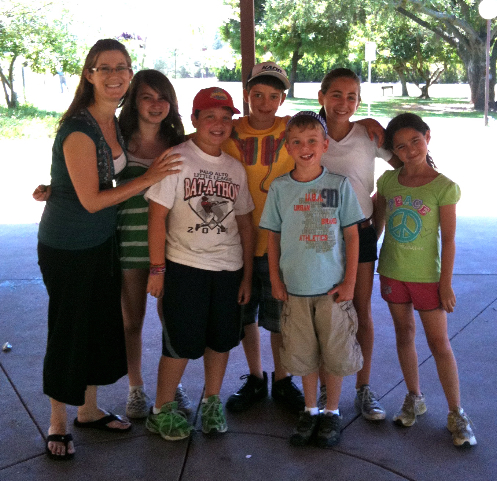 This week, we start the journey towards the end of the Torah by reading Parashat Devarim, the first Torah portion in the book of Deuteronomy. Moses re-explains the Torah to the Israelites, making sure that every Israelite understands and internalizes the message of their mighty passage from Egypt to the Promised Land: This week, we start the journey towards the end of the Torah by reading Parashat Devarim, the first Torah portion in the book of Deuteronomy. Moses re-explains the Torah to the Israelites, making sure that every Israelite understands and internalizes the message of their mighty passage from Egypt to the Promised Land:
On the other side of the Jordan, in the land of Moav, Moshe began to explain the Torah, saying: God spoke to us at Chorev (Sinai), saying, You have stayed long enough at this mountain;Turn, and take your journey, and go to the mountain of the Amorites, and to all the places near there, to the Aravah, to the hills, and to the lowlands, and to the Negev, and by the sea side, to the land of the Canaanites, and to Lebanon, to the great river, the river Euphrates. Behold, I have set the land before you; go in and possess the land which God swore to your fathers, Abraham, Isaac, and Jacob, to give to them and to their seed after them... God has multiplied you, and behold, you are today as many as the stars of heaven.
Being at Mount Sinai was the apex of our revelation and the point of coalescence for our community. It remains a sacred, almost mythical moment in the collective Jewish imagination. So why would God urge the people to get up and continue their journey? Why accuse the Israelites of staying too long at Sinai, rav lachem shevet ba'har hazeh? The pshat or initial understanding of this verse gives us a sense of God's impatience with these sluggish Israelites who have a hard time "getting into gear." However, the famous commentator Rashi offers us another way to read this phrase in the spirit of the Midrash. The word phrase rav (too much/ too long) is closely related to the word harbeh (great, much). We can read this phrase as harbeh lachem shevet ba'har hezeh- you have gotten so much out of your time staying at this mountain! You received the Torah, set up your Sanhedrin courts, built the Mishkan, and learned how to serve God with the proper tools and instruments. You have grown so much as a community, and Sinai has given you all you need to continue on your journey.
The campers are about to experience their last Ramah Shabbat of the summer. For some, this was their longest stretch away from their parents and their homes. They might be ready to go home - rav lachem shevet. For others, this is the highlight of their year and maybe their whole childhood. They can't imagine leaving this place, the emotional center of their Jewish identity. These campers need the strength and support to move on with their journeys through life. We remind them - harbeh lachem shevet, you have gained so much from this experience, and you will bring camp with you into every twist and turn on your life's path.
Camp Ramah can often feel like the Promised Land. When the session comes to a close, we are gently reminded that camp is more like Sinai. It is a place of great connection to God, community, nature, and our highest self. It is also a place that gives us tools to move forward, charging us to channel our Jewish spirit as a force for good in the world and to maintain both the self-confidence and the sense of caring for others that leads us to deep and healthy relationships throughout our lives. I hope that your children's experiences this summer at their own Sinai, Camp Ramah in Ojai, guide them towards more and more blessing and helps them arrive at the Promised Land, a life infused with Jewish values and overflowing with love, joy, fulfillment and connection.
Rabbi Laurie Matzkin is the Director of Lifelong Learning at Congregation Kol Emeth in Palo Alto, California. |
Kesher Tefillin:
Building a Spiritual Connection to an Ancient Ritual
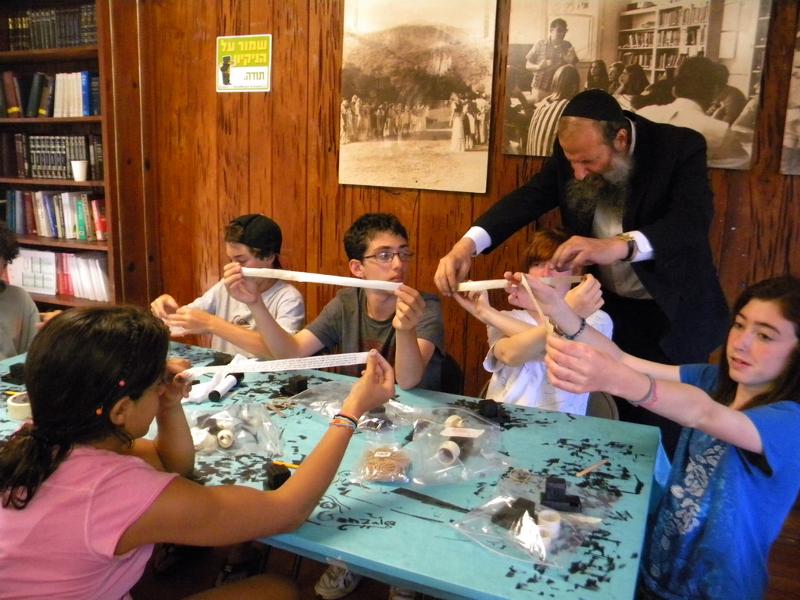 To a layperson, or perhaps someone who has never used them, tefillin may look mysterious. What do you do with them? What's inside the little boxes? Will it hurt? But when a person makes a set of tefillin him- or herself, learning the complex Jewish law that dictates how they are made, laboring over every tedious (yet crucial) detail along the way, something wondrous happens: tefillin become treasured and, even more unusual, kids become excited about them. This is exactly what has happened at Camp Ramah this week for a group of 21 Sollelim campers selected for a unique tefillin-making workshop with Noah Greenberg, a Berkeley-born artist who has lived in Safed, Israel for the past 30 years. To a layperson, or perhaps someone who has never used them, tefillin may look mysterious. What do you do with them? What's inside the little boxes? Will it hurt? But when a person makes a set of tefillin him- or herself, learning the complex Jewish law that dictates how they are made, laboring over every tedious (yet crucial) detail along the way, something wondrous happens: tefillin become treasured and, even more unusual, kids become excited about them. This is exactly what has happened at Camp Ramah this week for a group of 21 Sollelim campers selected for a unique tefillin-making workshop with Noah Greenberg, a Berkeley-born artist who has lived in Safed, Israel for the past 30 years.
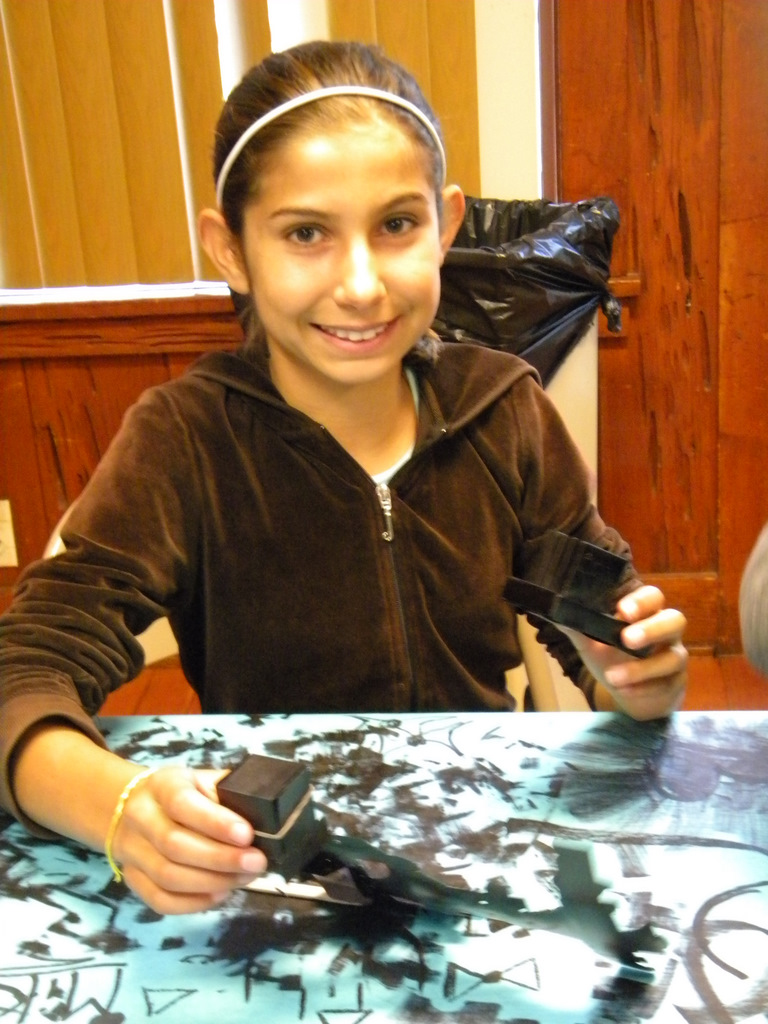 Several years ago while learning with one of his eight children for his bar mitzvah, Greenberg began questioning why tefillin needed to be so sophisticated, made of ¼-inch thick pressed leather using complicated machinery. After all, he thought, Moshe Rabeinu made his own tefillin, and surely he didn't have access to sophisticated machines. Creating a set of tefillin from klaf (the animal-skin parchment used in writing Sifrei Torah and mezuzah scrolls)--and making them in a way that he could share with his son and other bar mitzvah age children--became a personal challenge for him. Greenberg settled on goat skin, which is stiffer than calf skin, for the structure of the batim (boxes), gathered the remaining materials and reference books, and set to work. Once completed, he took his tefillin to several rabbinic authorities to make sure they were kosher to use. "They are kosher," the rabbis said, "but what are you going to do with them?" Several years ago while learning with one of his eight children for his bar mitzvah, Greenberg began questioning why tefillin needed to be so sophisticated, made of ¼-inch thick pressed leather using complicated machinery. After all, he thought, Moshe Rabeinu made his own tefillin, and surely he didn't have access to sophisticated machines. Creating a set of tefillin from klaf (the animal-skin parchment used in writing Sifrei Torah and mezuzah scrolls)--and making them in a way that he could share with his son and other bar mitzvah age children--became a personal challenge for him. Greenberg settled on goat skin, which is stiffer than calf skin, for the structure of the batim (boxes), gathered the remaining materials and reference books, and set to work. Once completed, he took his tefillin to several rabbinic authorities to make sure they were kosher to use. "They are kosher," the rabbis said, "but what are you going to do with them?"
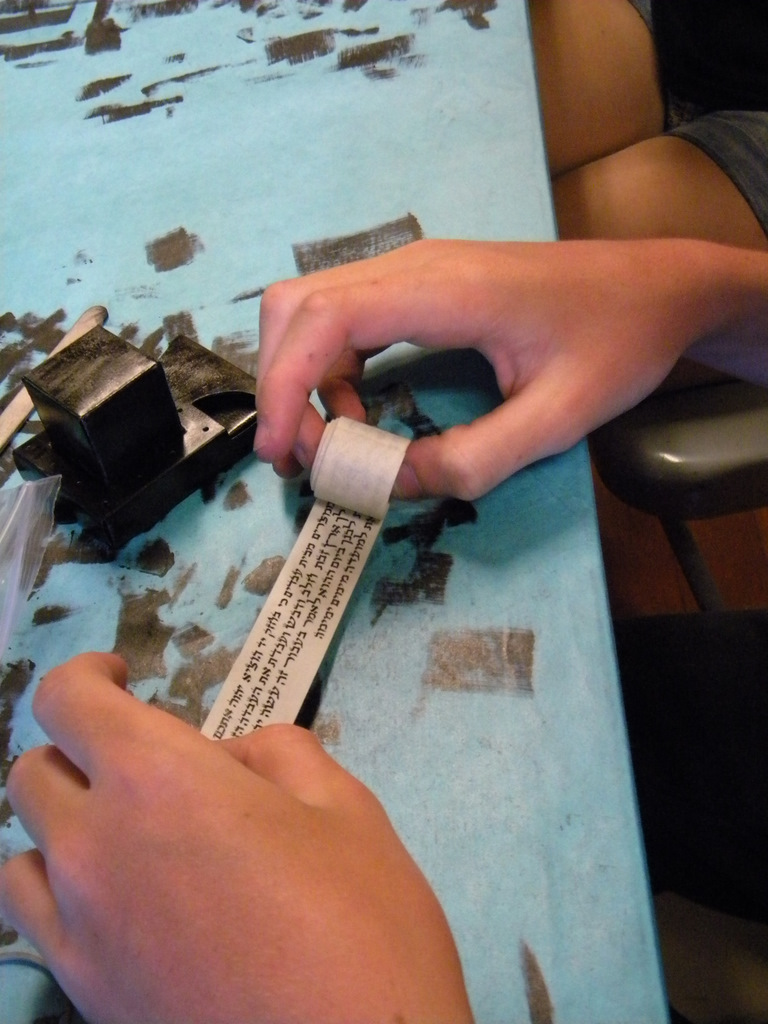 The answer to that question came from an unlikely source--Ramah Darom in the north Georgia mountains. Greenberg had been teaching at Darom for several summers, as well as presenting the Tree of Life Shtender, which he created with artist David Moss. Loren Sykes, then director of Ramah Darom, had visited Greenberg's studio in Safed and had seen his handmade tefillin. Sykes invited Greenberg to create a pilot workshop, called Kesher Tefillin, for twelve pre-bar mitzvah campers in the summer of 2007. The workshop was intense, with at least fourteen hours of dedicated work time, which necessitated taking campers out of regular activities. At first, there was concern that campers would balk at being taken away from sports, arts & crafts, or just hanging out with their camp friends. But within days of beginning the workshop, "the excitement was unbelievable. The energy level was mind-boggling," Greenberg said. "Kids were coming ten minutes early to sessions." The answer to that question came from an unlikely source--Ramah Darom in the north Georgia mountains. Greenberg had been teaching at Darom for several summers, as well as presenting the Tree of Life Shtender, which he created with artist David Moss. Loren Sykes, then director of Ramah Darom, had visited Greenberg's studio in Safed and had seen his handmade tefillin. Sykes invited Greenberg to create a pilot workshop, called Kesher Tefillin, for twelve pre-bar mitzvah campers in the summer of 2007. The workshop was intense, with at least fourteen hours of dedicated work time, which necessitated taking campers out of regular activities. At first, there was concern that campers would balk at being taken away from sports, arts & crafts, or just hanging out with their camp friends. But within days of beginning the workshop, "the excitement was unbelievable. The energy level was mind-boggling," Greenberg said. "Kids were coming ten minutes early to sessions."
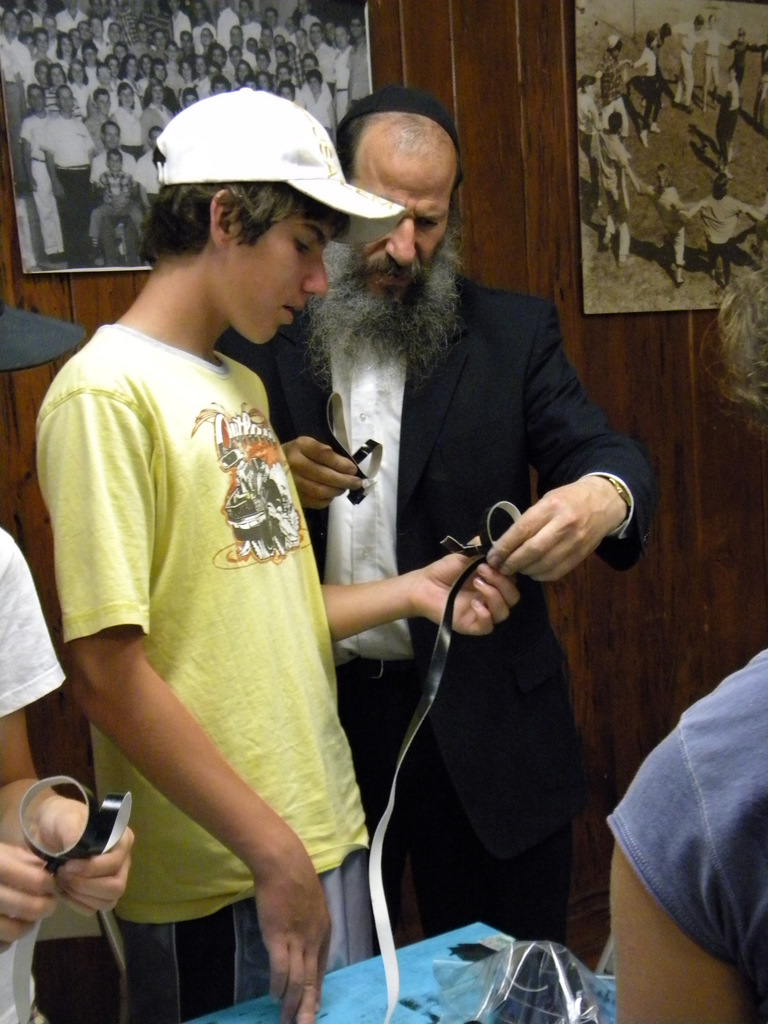 The excitement was not contained to the room in which the kids were folding klaf and tying knots in leather straps. The whole camp was excited about tefillin. "Tefillin had become something valuable and special to them, "Greenberg said. One participant funded Greenberg's return to Darom the following summer with his own bar mitzvah money. Another participant spoke about his experience in the Kesher Tefillin workshop in his bar mitzvah sermon. Others wrote their parents from camp to tell them they did not need to buy tefillin for their b'nai mitzvah, that they wanted to use the tefillin they made themselves. Even campers who did not participate in the workshop were finding Greenberg around camp and during meals to ask questions about tefillin. These children had developed a spiritual connection with tefillin--their tefillin--that would not have been so strong had they simply purchased a set from their local Judaica store or synagogue gift shop. The excitement was not contained to the room in which the kids were folding klaf and tying knots in leather straps. The whole camp was excited about tefillin. "Tefillin had become something valuable and special to them, "Greenberg said. One participant funded Greenberg's return to Darom the following summer with his own bar mitzvah money. Another participant spoke about his experience in the Kesher Tefillin workshop in his bar mitzvah sermon. Others wrote their parents from camp to tell them they did not need to buy tefillin for their b'nai mitzvah, that they wanted to use the tefillin they made themselves. Even campers who did not participate in the workshop were finding Greenberg around camp and during meals to ask questions about tefillin. These children had developed a spiritual connection with tefillin--their tefillin--that would not have been so strong had they simply purchased a set from their local Judaica store or synagogue gift shop.
Greenberg intersperses his sometimes complicated directions for making the tefillin with tidbits of Jewish law, stories from the Gemara, and constant reminders to keep on task; a well-rehearsed refrain in the room throughout the week is "l'shem kedushas tefillin" (for the holiness of tefillin). Greenberg is a blur of motion as he zips around the room, helping to tie knots and checking progress to make sure everything is correct.
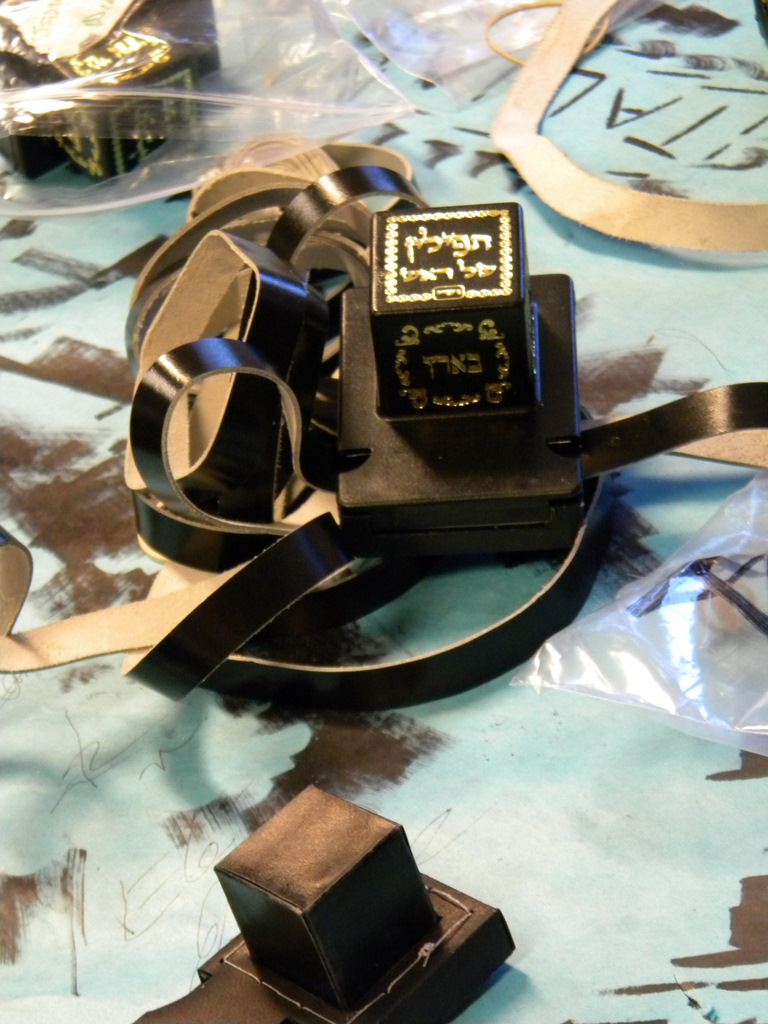 The impact on this summer's Sollelim participants is clear. Their questions are endless, and Greenberg always takes the time to explain the halacha or tell another story. "The kids here know all the answers to the questions," Greenberg says about the participants. "I have a kollel in Israel. I think that the kids here know more details about tefillin than many of the people learning in the kollel." The impact on this summer's Sollelim participants is clear. Their questions are endless, and Greenberg always takes the time to explain the halacha or tell another story. "The kids here know all the answers to the questions," Greenberg says about the participants. "I have a kollel in Israel. I think that the kids here know more details about tefillin than many of the people learning in the kollel."
Max Helfand, a camper from Los Angeles, describes his favorite part of the workshop as getting to put the parshiyot inside the tefillin himself. "It's amazing that I got to make the tefillin on my own," he says. Aaron Boudaie, from Beverly Hills, enjoyed "when the tefillin started to really look like tefillin." Another participant, Aaron Azizi from Beverly Hills, was particularly moved by Greenberg's teaching that "tefillin is like a witness to saying the Shema, to your promise to God." Los Angeles native Mia Ehrenberg summed up the experience by saying, "Making tefillin with my friends is cool."
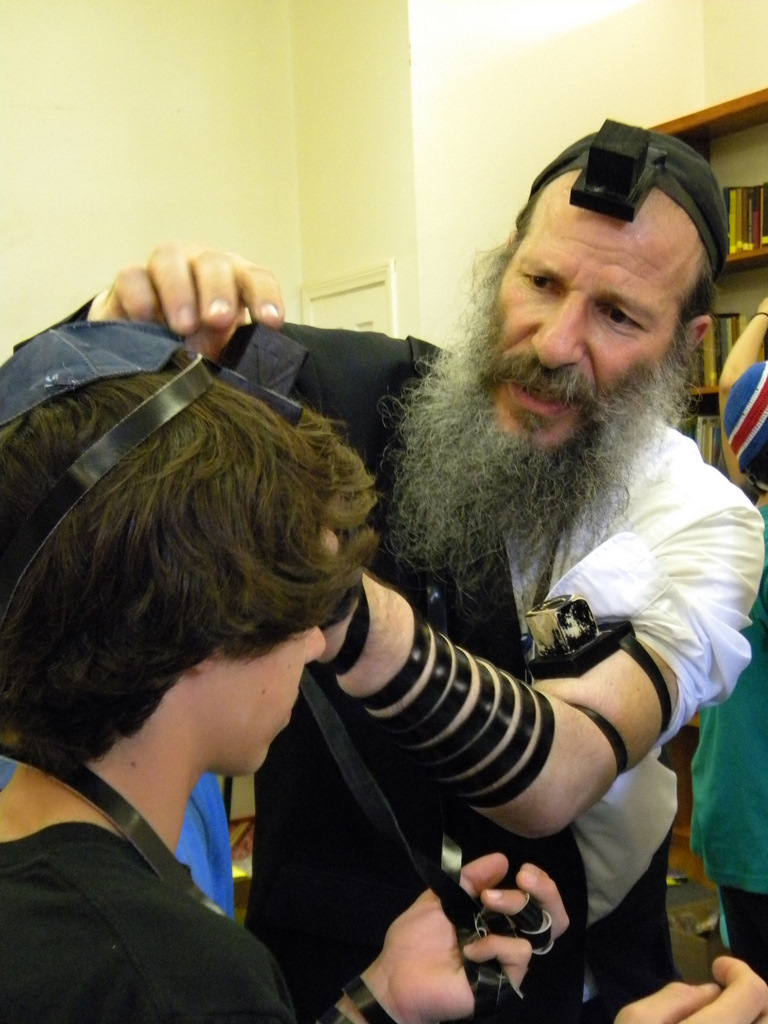 Greenberg's favorite part of the workshop is at the end, when the campers put in their tefillin for the first time. They say a bracha and the Shema together as a group. "When you say the Shema with tefillin on, you are supposed to touch the tefillin. It's really powerful," says Greenberg. Greenberg's favorite part of the workshop is at the end, when the campers put in their tefillin for the first time. They say a bracha and the Shema together as a group. "When you say the Shema with tefillin on, you are supposed to touch the tefillin. It's really powerful," says Greenberg.
Greenberg is touched by how much the workshop affects the participants, even years later. He relates a story of a camper who reminded him that he participated in the workshop three years earlier and spoke proudly of how he still wears his tefillin every day. "The beauty is that you can't tell the impact you are having on the kids for years," he says about both the tefillin workshop and viewing the shtender presentation. "When you see the smiles on those kids' faces, it's all worthwhile."
A generous grant by three Camp Ramah families helped Greenberg to bring his Kesher Tefillin workshop to Camp Ramah in California this summer. In addition to the workshop, Greenberg has also presented the amazing Tree of Life Shtender to every edah at camp throughout his week in residence. As the success and excitement of the previous years' Kesher Tefillin workshops demonstrated, if a person really works at something, really invests in it, it will be valuable and meaningful to him. It's a well-known tenet of psychology, but sometimes it takes an ancient ritual object for that simple truth to really come to life.
For more information about the Kesher Tefillin Program, please visit www.kesher-refillin.com. For more information on the Tree of Life Shtender, please visit www.bezalel-editions.net. To view photos of the Kesher Tefillin workshop from Camp Ramah in California, please visit our website and look in the July 11 album. |
|
B'Tzelem Elokeem
The following reflection, compiled by yahadut teacher Vicki Helfand, is based on responses from her class of Sollelim girlsto the question, "What does it mean to you to be created B'tezelem Elokeem?"
Betzelem Elokeem there is a place of G-d in all of us
We were created with color so we can be free and our souls can feel light.
Sometimes when life seems complicated and intense and full of drama
With twists and turns,
We try to remember that it also has light and color and beauty.
Betzelem Elokeem - even though life is not always a rainbow,
And things don't always go right,
We think about the circle of life and how we are born as a simple line and as we grow older, our problems grow...
But also our potential for what we can and should be
As young women we feel the changes of turning 13...
We feel the complexity of our friendships and the responsibility of our choices.
Life is not so simple.
But at the same time, it does have buds that blossom into roses
Betzelem Elokeem - we will strive to remember that we are created in G-d's image
We are special and light and colorful and complex and wise and dramatic and beautiful...all at the same time...
***
Betzelem Elokeem - when I look at each of you - I can clearly see how you were created in G-d's image...It has been a true pleasure getting to know each and every one of you. Your openness, sensitivity and honesty have been a gift...and I will miss you...
--Vicki Helfand |
|
|
|
Phone us: 888-Camp-Ramah
Write us: 15600 Mulholland
Suite 252
Los Angeles, CA 90077 |
|
|
|